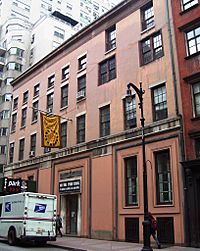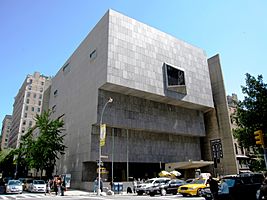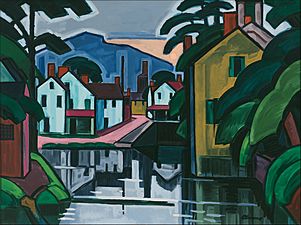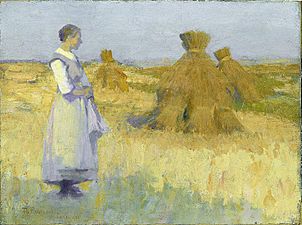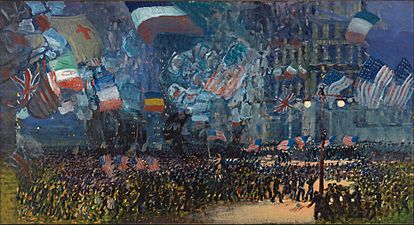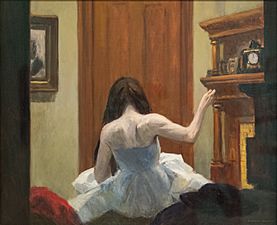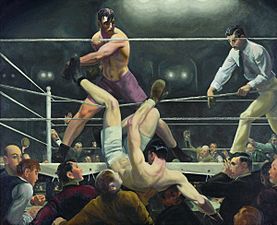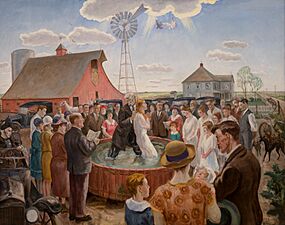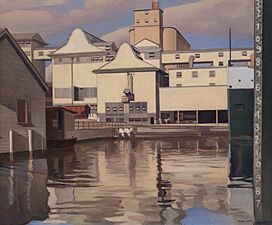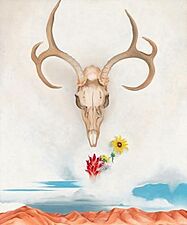Whitney Museum facts for kids
 |
|
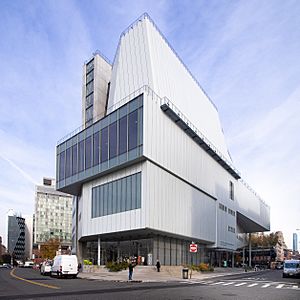
The front of the museum (2019)
|
|
| Established | 1930 |
|---|---|
| Location | 99 Gansevoort Street, Lower Manhattan, New York City |
| Type | Art museum |
| Visitors | 768,000 (2023) |
| Founder | Gertrude Vanderbilt Whitney |
| Architect | Renzo Piano |
| Public transit access | Subway: Bus: M11, M12, M14A, M14D |
The Whitney Museum of American Art, often called "The Whitney", is a famous art museum in New York City. It focuses on modern and contemporary American art. The museum was started in 1930 by Gertrude Vanderbilt Whitney, a well-known American sculptor and art supporter.
The Whitney collects and saves American art from the 20th and 21st centuries. Its huge collection has over 25,000 artworks by more than 3,500 artists. These include paintings, sculptures, drawings, photos, films, and videos. The museum especially likes to show art by living artists. It also keeps important historical documents about American art. For example, it has the largest collection of Edward Hopper's artwork and papers.
From 1966 to 2014, the Whitney was on the Upper East Side of Manhattan. It moved to its current building in the Meatpacking District on May 1, 2015. This new building was designed by Renzo Piano. It has much more space for art shows.
The museum also hosts the Whitney Biennial. This is a big art show that happens every two years. It features new and exciting American artists. It's considered a very important show for contemporary art in the United States. The Whitney also runs a program called the Whitney Independent Study Program. This program helps artists, art critics, and art historians learn more about art. In 2023, the Whitney had 768,000 visitors. This made it one of the most visited museums in the United States.
Contents
History of the Whitney Museum
How the Museum Started
Gertrude Vanderbilt Whitney was a talented sculptor and a serious art collector. She started buying art in 1905. She also ran art spaces called the Whitney Studio and Whitney Studio Club from 1914 to 1928. These places helped new American artists show their work. Gertrude Whitney liked the art of the Ashcan School artists, like John Sloan and Edward Hopper.
By 1929, Gertrude Whitney had collected almost 700 American artworks. She offered to give over 500 of them to the Metropolitan Museum of Art. But that museum said no. Also, the new Museum of Modern Art seemed to prefer European art. So, Gertrude Whitney decided to open her own museum just for American art in 1929.
The Whitney Museum of American Art officially opened on November 18, 1931. It was located in three old row houses on West 8th Street in Greenwich Village. One of these houses had been the Studio Club. Juliana Force became the museum's first director. She made sure the museum showed art by new and living American artists.
In 1954, the museum moved to a smaller building on 54th Street. This building was connected to the Museum of Modern Art.
Moving to the Upper East Side
In 1961, the Whitney started looking for a bigger home. In 1966, it moved to a new building on Madison Avenue and 75th Street. This building was designed by Marcel Breuer. It looked very modern with its unique staircase and trapezoidal windows.
Over the years, the museum often needed more space. It tried to expand its building several times, but these plans didn't work out. The museum also opened smaller art spaces in other parts of New York City and even in Stamford, Connecticut.
Moving Downtown
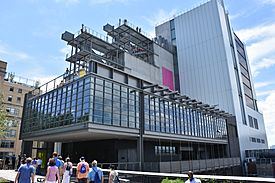
The Whitney built a brand new main building in the West Village and Meatpacking District. This new museum was designed by Renzo Piano. It is located at the start of the High Line park. Construction began in 2010, and the building cost $422 million. The new museum officially opened on May 1, 2015.
The new building is very large, with eight floors. It has huge art galleries without columns, an education center, a theater, and a library. Two floors are just for the museum's permanent collection. The building also has outdoor terraces and staircases with great views of the city. The new building's collection has over 600 artworks by more than 400 artists.
In 2019, there were some concerns raised about a member of the museum's Board of Trustees. These concerns led to several artists withdrawing their work from the Whitney Biennial. On July 25, 2019, the board member, Warren B. Kanders, decided to resign from the Board of Trustees.
The Whitney's Art Collection

The Whitney Museum shows many types of art. This includes paintings, drawings, prints, sculptures, installation art, video, and photography.
When the museum first opened, it had about 600 artworks. This grew to about 1,300 by 1954. After moving to the Breuer building in 1966, the collection grew to around 2,000 pieces. The museum started collecting photography in 1991. Today, the collection has more than 25,000 artworks by over 3,500 artists. These artworks cover art from the late 19th century to today.
Every two years, the museum holds the Whitney Biennial. This is a big art show that features many artists who are new to the American art scene. It has shown works by many famous artists. It has also featured unusual works, like a 1976 exhibit that included live body builders, including Arnold Schwarzenegger.
Besides its physical collection, the Whitney also has a website called Artport. This site shows "Net Art," which is art made for the internet. The museum has a special rule: it will not sell any work by a living artist. This is because selling their work could hurt their career. However, it might trade one piece by a living artist for another piece by the same artist.
Gallery of Artworks
-
Theodore Robinson, Etude, (1890)
-
Maurice Prendergast, Central Park, 1900, (1900)
-
Edward Hopper, New York Interior, c. 1921
-
George Bellows, Dempsey and Firpo, (1924)
-
Charles Demuth, My Egypt, 1927
-
Florine Stettheimer, New York/Liberty, 1918–1919
-
John Steuart Curry, Baptism in Kansas, 1928
-
Charles Sheeler, River Rouge Plant, 1932
-
Jasper Johns, Three Flags, 1958
-
Georgia O'Keeffe, Summer Days, 1936
The Whitney Library
The Frances Mulhall Achilles Library is a research library at the Whitney Museum. It started with the books and papers of Gertrude Vanderbilt Whitney and the museum's first director, Juliana Force. The library is located in the West Chelsea area of New York City.
It has special collections and the Whitney Museum Archives. The archives include records of exhibitions, photographs, and letters from artists. The special collections have artists' books, photos, and posters related to the museum's art collection.
Some important collections include:
- The Arshile Gorky research collection (from the 1920s to the 1990s)
- The Edward Hopper research collection (from 1894 to 2000)
You can find information about the books and materials in the library using the museum's online database.
Independent Study Program
The Whitney Independent Study Program (ISP) began in 1968. It helps artists, critics, and curators start their careers. Many well-known people in the art world have been part of this program.
Each year, the ISP chooses students for different programs. These include a Studio Program for artists, a Curatorial Program for curators, and a Critical Studies Program for scholars. It's a nine-month program where students learn from visiting artists, art historians, and critics.
How the Museum is Run
Funding the Museum
The Whitney Museum gets money from an endowment fund. This fund helps pay for the museum's yearly costs. In March 2011, the endowment was $207 million. By June 2016, it had grown to $308 million.
The museum also relies on private collectors and donors to buy new art. In 2008, Leonard A. Lauder gave the museum $131 million. This was the largest donation in the Whitney's history.
Museum Directors
The current director of the Whitney Museum is Scott Rothkopf. He became director in 2023. Past directors include Adam D. Weinberg (2003–2023) and Juliana Force (1931–1948).
Board of Trustees
For many years, Gertrude Vanderbilt Whitney supported the museum by herself. Her daughter, Flora Whitney Miller, continued this support. Until 1961, the museum's board was mostly made up of family members.
In 1961, the museum needed more help from outside. So, they added new trustees, like bankers Roy Neuberger. David Solinger became the Whitney's first president from outside the family in 1966.
See also
 In Spanish: Museo Whitney de Arte Estadounidense para niños
In Spanish: Museo Whitney de Arte Estadounidense para niños
- Whitney Museum of American Art (original building)
- List of museums and cultural institutions in New York City
- List of Whitney Biennial artists
- Whitney Biennial
- The Catalog Committee


